Instruction
Are you properly managing your club face? Try this experiment
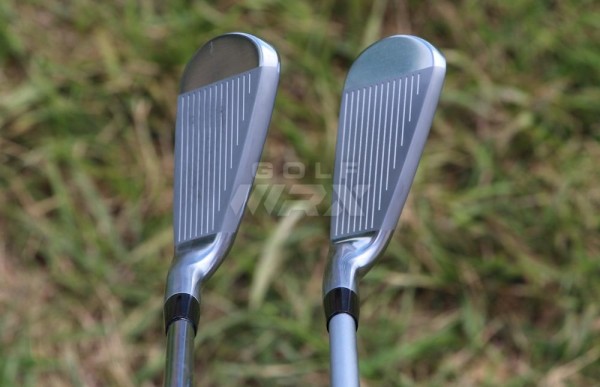
Recently, I performed an experiment on how golfers manage their club faces. I was curious to see how I could instinctively resolve the problem of executing a straight shot with an extremely open-face grip, as well as an extremely closed-face grip. Although both “golfers” are me, we will refer to the golfer with the extreme open-face grip as Owen and the golfer with the extremely closed-face grip as Chuck.
To perform the experiment, I used three different forms of measurement (video, FlightScope and BodiTrak) to capture and analyze data and make observations about how innate athleticism unconsciously solved the problem. My hope is that some of these observations might prove to be missing links to your quest to control the golf ball better — and that you might learn to trust your inner “athlete” on the course more often.
*Remember that these observations are not absolutes. They are simply one man’s way of resolving a problem. I do believe, however, that some of the observations I make will be useful images to help others resolve their stray ball flights.
Let’s start off with the FlightScope data. Note the obvious differences between Owen and Chuck’s use of the face-to-path relationship. Chuck instinctively swung the club head well out to the right to manage his club face that was pointing so drastically to the left. Note the exact opposite tendencies with Owen.
Now take a closer look at the BodiTrak information. Note how Chuck has less pressure on the backswing leg at the top of the swing and significantly more pressure toward the target leg at impact. Chuck instinctively recognizes that the more lateral his motion is toward the target, the golf club will be delivered into impact sooner than normal, and result in more of an open-faced position.
Note the exact opposite tendencies with Owen, who applies more pressure on the backswing leg at the top of the swing and makes less of a move laterally toward the target at impact. Owen recognizes that the hands and arms need more time to square up a club face that is so open, which can be achieved by making a later, smaller lateral move towards the target.
Finally, let’s take a look at the Video, starting with the set up. Chuck (right images) has the trail arm lower at the address position compared with Owen’s (left images), simply due to the different grips.
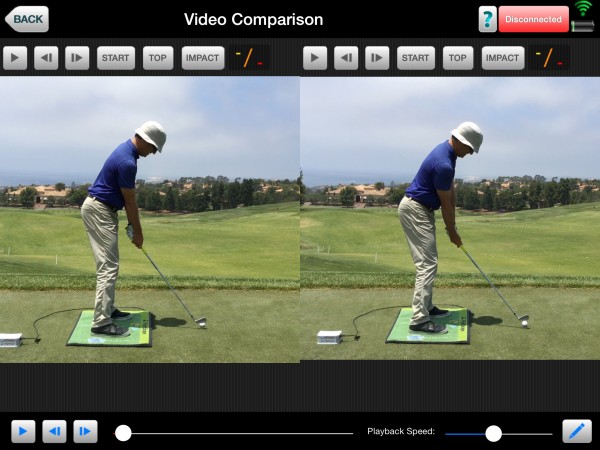
Chuck is on the right. Owen is on the left. The different grips changes their arm positioning at set up.
When the lead arm is parallel to the ground, Chuck has made a bigger turn away from the target and flattened his shoulder plane in an effort to set up his body to deliver the golf club on a more shallow downswing plane. He has started to cup his wrist in an effort to get the club face into more of an open-faced position.
Owen, on the other hand, is doing the exact opposite. He is trying to bow his wrists in an effort to make the club face more closed. He is not making as big of a turn on the backswing and his arm swing is more in front of his chest because he instinctively knows that he must prepare his body to swing left on the down swing to help manage his very open club face.
It is interesting to note how each “athlete” is preparing himself early during the backswing to help manage the drastic club face positions. Most backswings take approximately three times longer than the downswing. They are trying to maximize the additional time of their backswing motion.
At the top of the backswing, the characteristics of the previous position have continued their evolution. Chuck continues to make a bigger turn and cup his wrists. Owen continues to bow his wrists and make a smaller turn. Both positions are ultimately trying to give each respective golfer a better chance of succeeding by delivering the golf club on a path that will help them match up or manage their club face position.
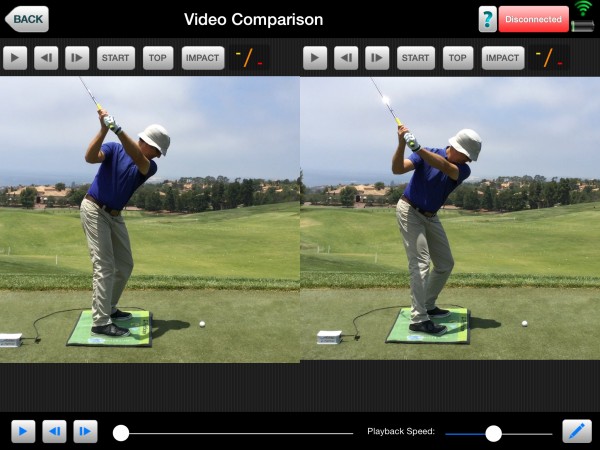
Note the different wrist conditions of each athlete, trying to neutralize their drastic club face positions. Note Owen’s smaller turn, resulting in more upright arm plane.
Now each athlete hopes to reap the rewards of their preparation. The downswing delivery of the golf club is producing a very different path for both Owen and Chuck. Owen is unwinding his body sooner, and delivering the golf club with a more upright shaft position. This should lead to a path that is more left of the club face at impact. Chuck is unwinding his body later and delivering the golf club with a more shallow shaft position. This should lead to a path that is more right of the club face at impact.
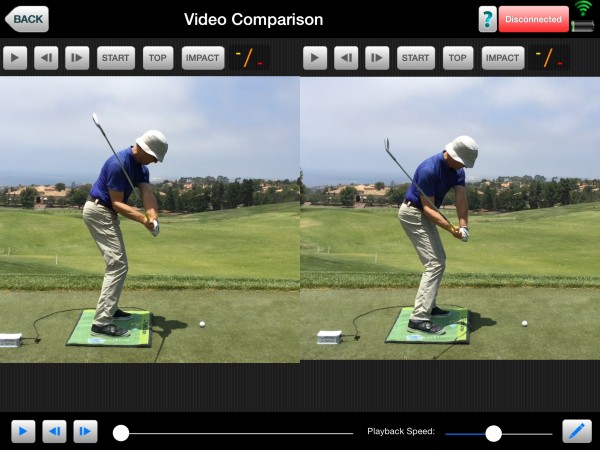
Note the different club face and shaft positions of each athlete. Even with bowed wrists, Owen’s club face is still open, and the shaft is on the lead arm. Note the exact opposite characteristics for Chuck. Also note Owen’s earlier unwind of his body.
The athletes have completed their mission, just past impact. Chuck continues to unwind his body later in the downswing sequence. This later unwind was instrumental in helping Chuck swing his golf club more right through impact. Owen has turned his body more towards the target at impact. This earlier unwind helped Owen swing the golf club more left through impact.
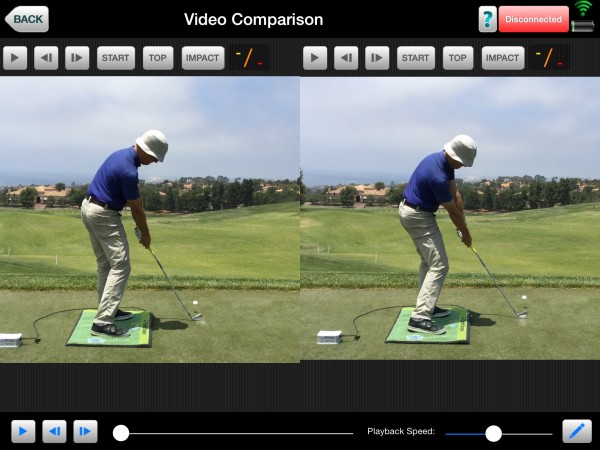
Both athletes succeeded! Chuck’s club face is still pointing to the right, past impact, for less of a hook. Owen’s club face is still pointing left, to help produce less of a slice.
In conclusion, because a primary goal of each golfer is to hit straight shots, managing his or her club face is an extremely important component to that execution. My hope is that each measuring device gave you clues to help solve the problem of managing your club face and hitting straighter shots.
- LIKE212
- LEGIT44
- WOW27
- LOL30
- IDHT7
- FLOP39
- OB25
- SHANK383
Instruction
Clement: Laid-off or perfect fade? Across-the-line or perfect draw?

Some call the image on the left laid off, but if you are hitting a fade, this could be a perfect backswing for it! Same for across the line for a draw! Stop racking your brain with perceived mistakes and simply match backswing to shot shape!
- LIKE0
- LEGIT0
- WOW0
- LOL0
- IDHT0
- FLOP0
- OB0
- SHANK0
Instruction
The Wedge Guy: The easiest-to-learn golf basic

My golf learning began with this simple fact – if you don’t have a fundamentally sound hold on the golf club, it is practically impossible for your body to execute a fundamentally sound golf swing. I’m still a big believer that the golf swing is much easier to execute if you begin with the proper hold on the club.
As you might imagine, I come into contact with hundreds of golfers of all skill levels. And it is very rare to see a good player with a bad hold on the golf club. There are some exceptions, for sure, but they are very few and very far between, and they typically have beat so many balls with their poor grip that they’ve found a way to work around it.
The reality of biophysics is that the body moves only in certain ways – and the particulars of the way you hold the golf club can totally prevent a sound swing motion that allows the club to release properly through the impact zone. The wonderful thing is that anyone can learn how to put a fundamentally sound hold on the golf club, and you can practice it anywhere your hands are not otherwise engaged, like watching TV or just sitting and relaxing.
Whether you prefer an overlap, interlock or full-finger (not baseball!) grip on the club, the same fundamentals apply. Here are the major grip faults I see most often, in the order of the frequency:
Mis-aligned hands
By this I mean that the palms of the two hands are not parallel to each other. Too many golfers have a weak left hand and strong right, or vice versa. The easiest way to learn how to hold the club with your palms aligned properly is to grip a plain wooden ruler or yardstick. It forces the hands to align properly and shows you how that feels. If you grip and re-grip a yardstick several times, then grip a club, you’ll see that the learning curve is almost immediate.
The position of the grip in the upper/left hand
I also observe many golfers who have the butt of the grip too far into the heel pad of the upper hand (the left hand for right-handed players). It’s amazing how much easier it is to release the club through the ball if even 1/4-1/2″ of the butt is beyond the left heel pad. Try this yourself to see what I mean. Swing the club freely with just your left hand and notice the difference in its release from when you hold it at the end of the grip, versus gripping down even a half inch.
To help you really understand how this works, go to the range and hit shots with your five-iron gripped down a full inch to make the club the same length as your seven-iron. You will probably see an amazing shot shape difference, and likely not see as much distance loss as you would expect.
Too much lower (right) hand on the club
It seems like almost all golfers of 8-10 handicap or higher have the club too far into the palm of the lower hand, because that feels “good” if you are trying to control the path of the clubhead to the ball. But the golf swing is not an effort to hit at the ball – it is a swing of the club. The proper hold on the club has the grip underneath the pad at the base of the fingers. This will likely feel “weak” to you — like you cannot control the club like that. EXACTLY. You should not be trying to control the club with your lower/master hand.
Gripping too tightly
Nearly all golfers hold the club too tightly, which tenses up the forearms and prevents a proper release of the club through impact. In order for the club to move back and through properly, you must feel that the club is controlled by the last three fingers of the upper hand, and the middle two fingers of the lower hand. If you engage your thumbs and forefingers in “holding” the club, the result will almost always be a grip that is too tight. Try this for yourself. Hold the club in your upper hand only, and squeeze firmly with just the last three fingers, with the forefinger and thumb off the club entirely. You have good control, but your forearms are not tense. Then begin to squeeze down with your thumb and forefinger and observe the tensing of the entire forearm. This is the way we are made, so the key to preventing tenseness in the arms is to hold the club very lightly with the “pinchers” — the thumbs and forefingers.
So, those are what I believe are the four fundamentals of a good grip. Anyone can learn them in their home or office very quickly. There is no easier way to improve your ball striking consistency and add distance than giving more attention to the way you hold the golf club.
More from the Wedge Guy
- The Wedge Guy: Golf mastery begins with your wedge game
- The Wedge Guy: Why golf is 20 times harder than brain surgery
- The Wedge Guy: Musings on the golf ball rollback
- LIKE86
- LEGIT13
- WOW6
- LOL1
- IDHT0
- FLOP4
- OB1
- SHANK8
Instruction
Clement: Stop ripping off your swing with this drill!

Not the dreaded headcover under the armpit drill! As if your body is defective and can’t function by itself! Have you seen how incredible the human machine is with all the incredible feats of agility all kinds of athletes are accomplishing? You think your body is so defective (the good Lord is laughing his head off at you) that it needs a headcover tucked under the armpit so you can swing like T-Rex?
- LIKE0
- LEGIT2
- WOW2
- LOL0
- IDHT0
- FLOP0
- OB0
- SHANK2
-

 19th Hole2 weeks ago
19th Hole2 weeks agoDave Portnoy places monstrous outright bet for the 2024 Masters
-

 19th Hole3 days ago
19th Hole3 days agoJustin Thomas on the equipment choice of Scottie Scheffler that he thinks is ‘weird’
-

 19th Hole2 weeks ago
19th Hole2 weeks agoTiger Woods arrives at 2024 Masters equipped with a putter that may surprise you
-

 19th Hole3 days ago
19th Hole3 days ago‘Absolutely crazy’ – Major champ lays into Patrick Cantlay over his decision on final hole of RBC Heritage
-

 19th Hole3 weeks ago
19th Hole3 weeks agoReport: Tiger Woods has ‘eliminated sex’ in preparation for the 2024 Masters
-

 19th Hole1 week ago
19th Hole1 week agoTwo star names reportedly blanked Jon Rahm all week at the Masters
-

 19th Hole1 week ago
19th Hole1 week agoReport: LIV Golf identifies latest star name they hope to sign to breakaway tour
-

 19th Hole1 week ago
19th Hole1 week agoNeal Shipley presser ends in awkward fashion after reporter claims Tiger handed him note on 8th fairway

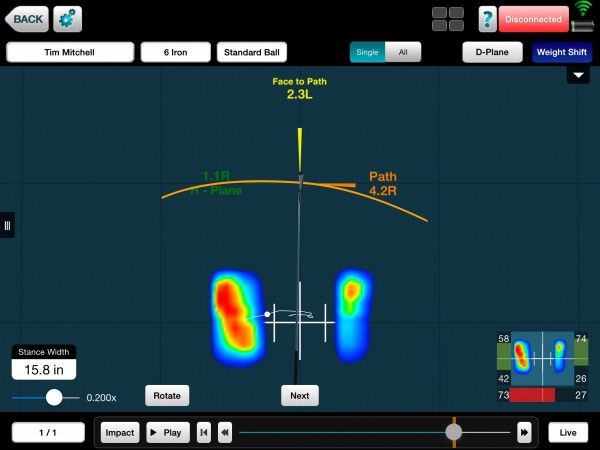
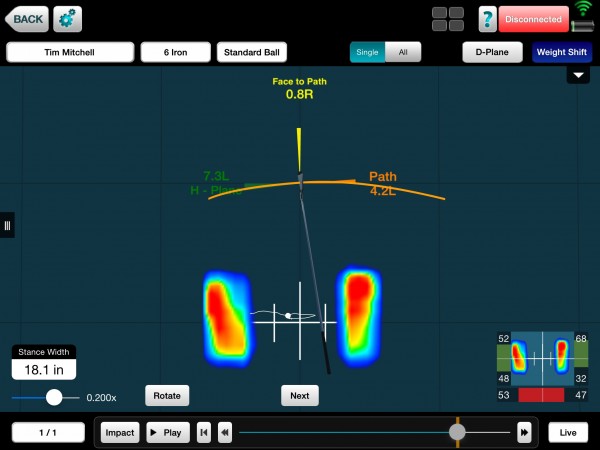
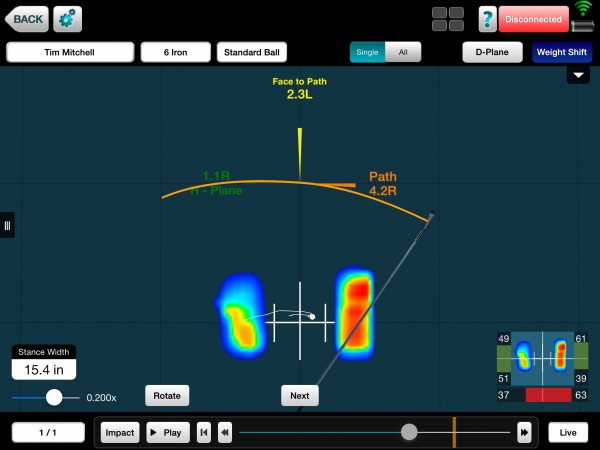
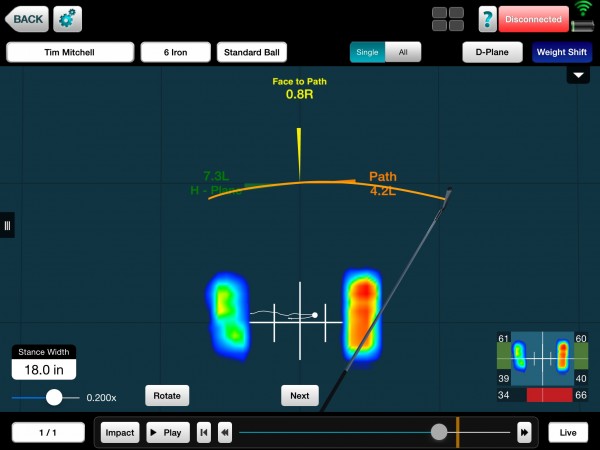
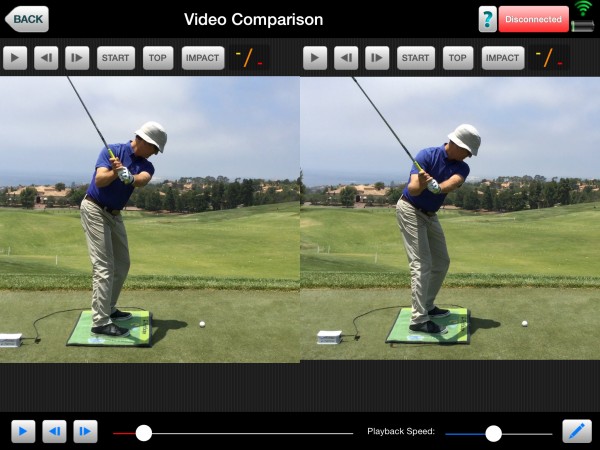














Joe Carrow
Jul 23, 2017 at 7:53 pm
I love these type of DATA driven article 🙂
Tim Schoch
Feb 28, 2017 at 8:26 am
I just found this article and read through the comments. I would suggest that no one has to duplicate the science and methodology employed to make the author’s conclusions in order to apply the knowledge to his/her own game. The joy of these articles is that in golf very simple things can make all the difference. For me, I yank the ball left every now and then, and this piece reminded me that turning too early in the followthrough could be the problem, or maybe it is my grip to begin with.
At any rate, I’d much rather have a well-organized article like this, full of photos and actually visual proof, than to hear some teacher on the radio tell me to strengthen my grip to get rid of my slice. For me, trying this method and “feeling” the swing and results reinforces my subconscious to step in and help me out if I go astray. If my subconscious does not help me out, it isn’t because the article is flawed, it is because I didn’t practice enough, and practice correctly.
Bob Pegram
May 16, 2016 at 2:16 pm
This article illustrates why learning to intentionally hit crooked shots helps your golf swing. If you learn how to hit the ball crooked on purpose, you then know how not to swing on the course. You also learn swing path and wrist/grip control. The way you use your wrists can make the ball go in different directions depending on which way you use them. You will have way more control of ball behavior.
Shankmaster
Dec 5, 2015 at 6:47 pm
You guys hurt Tim’s feelings, hope your happy!!!
Bob Jones
Dec 3, 2015 at 10:07 am
What I get from this article is that your swing a grip have to fit. You can’t have a strong grip and swing like you have neutral one, and vice versa.
Chris C.
Dec 1, 2015 at 12:25 am
First, I would like to thank Mr. Mitchell for sharing his insights. Second, I hope that my own observations are not met with Jack Nicholson like tirades. I respectfully submit that the swing manipulations demonstrated by Mr. Mitchell are far from instinctual. Instead, they are the result of Mr. Mitchell’s skill as a golfer. It is obvious that some have found this article instructive. Alas! I fail to grasp the point of this article and that is probably on me. Some years ago I was lucky enough to attend a demonstration put on by Bob Brue. He would strike balls alternating lay standing only on right leg then his left leg. He would use a ridiculously strong grip and a ridiculously weak grip. It did not matter how he started the swing. Every shot was a tight draw. Instinct had nothing to do with the results. The shots were the end result of a lifetime of honing his skill to insure that the bottom of each and every swing made solid square contact with the balls. Again, the point I am trying to make is that the various accommodations demonstrated by Mr. Mitchell are the polar opposite of instinctual. I much prefer tutorials assisting me in perfecting my grip; improving my swing and making it easier drop into the slot. Sadly, this article is not one to be saved.
Travis Saxton
Nov 29, 2015 at 10:06 pm
This is a great article. I’m attempting to make a transition from Owen to chuck and I’m nearly there. This reinforces several of my swing thoughts.
Louie
Jul 15, 2016 at 3:31 am
I think most amateurs would prefer Chuck over Owen….and even low handicappers turn into Owen from time to time….Tim is a very good player and just has better control over it…lol
Mad-Mex
Nov 28, 2015 at 10:56 pm
ATTENTION TIM!!!!!!!
These are the type of articles which made me stop buying Golf Magazines!!!
Tim the average player does not have access to the equipment you used!! How can US the general public who does not play in Private and $200+ green fee courses perform the same tasks WITHOUT SAID equipment!!!
And a little tip, next time you want to publish something to help golfers think of the average muni player and maybe of something which has not been tried.
prime21
Nov 29, 2015 at 7:28 am
1st of all, do you pay to belong to Golfwrx? 2nd, did ANYONE hold a gun to your dome and make you read the article? I bet SOMEWHERE at a local muni, there is a closed face Average Joe, as well as a open faced Average Joe, and Tim just helped show them how to square up their faces at impact, so that they could play better golf. What was also GREAT about the article was that he included PICTURES which showed the positional differences of how each player is able to find “neutral”. These pictures could be taken on a free app or GASP….one may have to shell out $100 for a high speed camera. This price can certainly be justified by anyone SERIOUS about getting better, especially considering an Instructor who probably receives $200/hr just laid out a detailed “how to” game plan to do it. So instead of making this an unwarranted attack involving socioeconomic undertones and ridiculous commentary, why not just say THANKS FOR THE FREE ARTICLE TIM, IT WAS GREAT! I DO NOT HAVE ACCESS TO THE EQUIPMENT THAT YOU USED, BUT BECAUSE YOU GAVE US A DETAILED PLAN ON HOW TO OVERCOME OUR ISSUES, I NOW HAVE SOMETHING TO WORK ON WHEN I GO TO THE RANGE NEXT. USUALLY FOR CHRISTMAS, MY MOTHER WAVES MY MONTHY RENT FEE, SO I SHOULD BE ABLE TO GET TO THE RANGE AT LEAST TWICE NEXT MONTH. IF SHE LETS ME USE HER SMARTPHONE, I WILL BE ALL SET! THANKS AGAIN & MERRY CHRISTMAS TO ALL!
ungratefulPOS
Nov 29, 2015 at 3:01 pm
Mex, you are a piece of work. Why do you need a bodi trak, or a flightscope to measure this yourself. He provided the results of the differing actions so that the “average muni player” can relate to the positions. Moving weight vs. pressure in the swing, arm position in p5 and how that relates to p7. P1 reference point of grip and the effect that has on the swing.. He broke this article down into such safe terminology that the average person should be able to understand what he is saying. You need to calm yourself, people like you are the types that don’t come and get lessons from a professional, and then you complain that you can’t break 100. Give your head a shake and thank the man for his time. Golf professionals don’t exactly get the luxury of 8 hour work days, so you should be thankful that he put together the extra 2 hours of writing, formatting, and editing. That’s time away from his family and it is to help the average golfer.
You are selfish, and I am disgusted by your ignorance.
Tom
Nov 28, 2015 at 10:27 am
I’ll work on this as soon as I loose the ten pounds I’ve gained this holiday season
Mat
Nov 28, 2015 at 3:39 pm
Lose? ¯\_(?)_/¯
Tom
Nov 30, 2015 at 11:43 am
Awww thank you..that too.